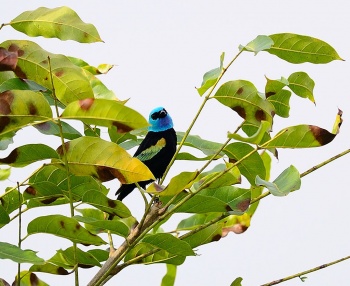m |
m (→External Links: removed BFTV link) |
||
| (4 intermediate revisions by 4 users not shown) | |||
| Line 1: | Line 1: | ||
| − | + | [[Image:Blue-necked_Tanager.jpg|thumb|550px|right|Photo © by {{user|juninho|juninho}} <br /> Photographed at Inca Pueblo Hotel, [[Machu Picchu]], [[Peru]] October 2005]] | |
| − | [[ | + | ;[[:Category:Stilpnia|Stilpnia]] cyanicollis |
| + | ''Tangara cyanicollis'' | ||
==Identification== | ==Identification== | ||
| + | 12 cm | ||
| + | *Blue hood and throat | ||
| + | *Turquoise-green wing [[Topography#General Anatomy|coverts]], wing edges and rump | ||
| + | *Gold shoulders | ||
| + | *Black, violet or blue underparts | ||
| + | *Black bill, legs and feet<br /> | ||
| + | '''Juvenile''' - brownish grey | ||
| + | [[Image:Blue-necked Tanager1.JPG|thumb|350px|right|Subspecies ''hannahiae''<br />Photo by {{user|Luis+R|Luis R}}<br />La Azulita, Estado Mérida, [[Venezuela]], March 2013]] | ||
==Distribution== | ==Distribution== | ||
| − | [[ | + | [[South America]]: found in [[Colombia]], [[Venezuela]], [[Ecuador]], [[Peru]], [[Bolivia]] and [[Brazil]] |
| + | |||
==Taxonomy== | ==Taxonomy== | ||
| + | This species used to be placed in genus ''[[:Category:Tangara|Tangara]]''. | ||
| + | ====Subspecies==== | ||
| + | There are 7 subspecies<sup>[[#References|[1]]]</sup>: | ||
| + | *''S. c. granadensis'': | ||
| + | :*Andes of [[Colombia]] | ||
| + | *''S. c. caeruleocephala'': | ||
| + | :*Eastern Andes of central Colombia to eastern [[Ecuador]] and northern [[Peru]] | ||
| + | *''S. c. hannahiae'': | ||
| + | :*Colombia (east of Eastern Andes) and western [[Venezuela]] | ||
| + | [[Image:DSC01367 copy Medium .jpg|thumb|350px|right|Blue-bellied type<br />Photo © by {{user|Digitalbcon|Digitalbcon}}<br />La Vega, Cundinamarca, [[Colombia]], November 2010]] | ||
| + | *''S. c. cyanopygia'': | ||
| + | :*Western Ecuador | ||
| + | *''S. c. cyanicollis'': | ||
| + | :*Eastern Peru (north to Huánuco) and easterb [[Bolivia]] | ||
| + | *''S. c. melanogaster'': | ||
| + | :*Western Amazonian [[Brazil]] (Amazon drainage of western Mato Grosso) | ||
| + | *''S. c. albotibialis'': | ||
| + | :*Eastern Brazil (southern Pará and southern Goiás) | ||
==Habitat== | ==Habitat== | ||
| + | Montane cloud and disturbed secondary forest. Upland gardens and agricultural land. Observed at heights around 2040 m. | ||
| + | ==Behaviour== | ||
| + | ====Diet==== | ||
| + | Their main diet consists of fruit; with the addition of insects and flower buds. | ||
| + | ====Breeding==== | ||
| + | The nest is a moss cup built by the female. The clutch consists of 2 brown-spotted white eggs, which are incubated for 13-14 days, the chicks fledging 15-16 days later. | ||
| + | ==References== | ||
| + | #{{Ref-Clements6thAug19}}#Avibase | ||
| + | #Handbook of the Birds of the World Alive (retrieved January 2015) | ||
| + | #BF Member observations | ||
| + | #Wikipedia | ||
| + | {{ref}} | ||
==External Links== | ==External Links== | ||
| − | {{GSearch|Tangara | + | {{GSearch|"Stilpnia cyanicollis" {{!}} "Blue-necked Tanager" {{!}} "Tangara cyanicollis"}} |
| + | {{GS-checked}}1 | ||
| + | <br /> | ||
| + | <br /> | ||
| − | [[Category:Birds]] [[Category: | + | [[Category:Birds]] [[Category:Stilpnia]] |
Latest revision as of 16:41, 23 June 2023
- Stilpnia cyanicollis
Tangara cyanicollis
Identification
12 cm
- Blue hood and throat
- Turquoise-green wing coverts, wing edges and rump
- Gold shoulders
- Black, violet or blue underparts
- Black bill, legs and feet
Juvenile - brownish grey
Distribution
South America: found in Colombia, Venezuela, Ecuador, Peru, Bolivia and Brazil
Taxonomy
This species used to be placed in genus Tangara.
Subspecies
There are 7 subspecies[1]:
- S. c. granadensis:
- Andes of Colombia
- S. c. caeruleocephala:
- S. c. hannahiae:
- Colombia (east of Eastern Andes) and western Venezuela
- S. c. cyanopygia:
- Western Ecuador
- S. c. cyanicollis:
- Eastern Peru (north to Huánuco) and easterb Bolivia
- S. c. melanogaster:
- Western Amazonian Brazil (Amazon drainage of western Mato Grosso)
- S. c. albotibialis:
- Eastern Brazil (southern Pará and southern Goiás)
Habitat
Montane cloud and disturbed secondary forest. Upland gardens and agricultural land. Observed at heights around 2040 m.
Behaviour
Diet
Their main diet consists of fruit; with the addition of insects and flower buds.
Breeding
The nest is a moss cup built by the female. The clutch consists of 2 brown-spotted white eggs, which are incubated for 13-14 days, the chicks fledging 15-16 days later.
References
- Clements, J. F., T. S. Schulenberg, M. J. Iliff, S. M. Billerman, T. A. Fredericks, B. L. Sullivan, and C. L. Wood. 2019. The eBird/Clements Checklist of Birds of the World: v2019. Downloaded from http://www.birds.cornell.edu/clementschecklist/download/
- Avibase
- Handbook of the Birds of the World Alive (retrieved January 2015)
- BF Member observations
- Wikipedia
Recommended Citation
- BirdForum Opus contributors. (2024) Blue-necked Tanager. In: BirdForum, the forum for wild birds and birding. Retrieved 21 December 2024 from https://www.birdforum.net/opus/Blue-necked_Tanager
External Links
GSearch checked for 2020 platform.1






